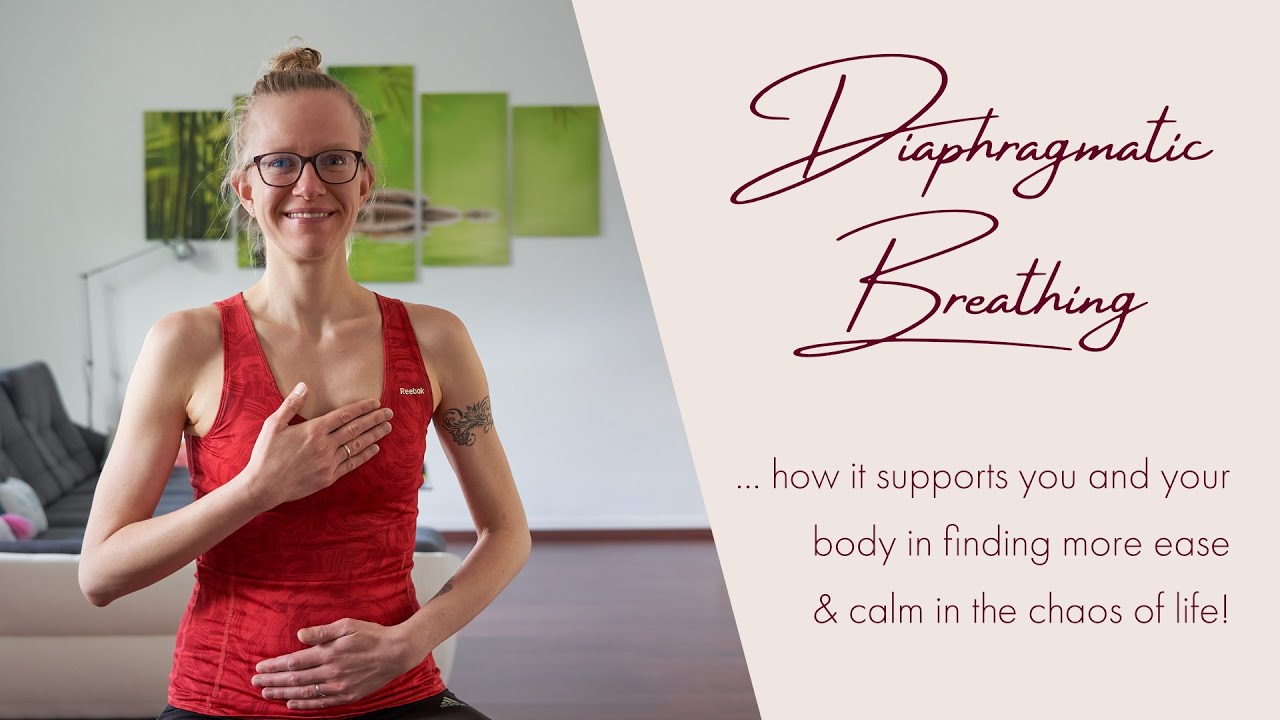What it is, how you do it and how it can support you and your body find more ease and calm in the chaos of life
What is the Diaphragm and what is Diaphragmatic Breathing?
Diaphragmatic breathing is also called belly breathing or abdominal breathing, but it is not a breathing technique that you have to learn. It’s our natural state of breathing when we are in a relaxed and comfortable place, when we feel safe.
The diaphragm is a dome-shaped muscle at the base of your lungs, just below your ribcage. When you breathe in with the diaphragm, it extends into your belly, pressing your organs and belly out a little bit, hence the term “belly breathing”. Your lungs are filled with oxygen. And on release, it presses all the air back out of your lungs.
That’s what it is, basically. Breathing in and out with the diaphragm.
When you look at babies, they still do it naturally. And we do it, too, when we’re in resting mode – which in today’s society we’re most often not :-)
But that’s why it’s important to be aware when we breathe with our diaphragm and when we might have stopped, breathing shallowly into our chest (upper lungs) instead.
Improving your Health with Diaphragmatic Breathing
Diaphragmatic breathing is super beneficial in keeping your whole body, but especially the nervous system, lymphatic system and endocrine system in a healthy state.
Relaxation Response
Diaphragmatic Breathing is THE gamechanger if you’re looking for more rest and relaxation in your life. Especially when you have a hard time meditating or quieting down the constant chatter and worry of your mind.
Because it fosters a relaxation response in your body.
So if it’s hard for you to switch off, you experience a lot of stress and overwhelm, or suffer from anxiety, actively breathing with your diaphragm creates immediate relaxation in your body. And when your body relaxes, your mind can also start to slow down.
We sometimes believe we need to feverishly change or calm down our thoughts to make our body relax. Which may work well, don’t get me wrong – but it works the other way around, too.
By influencing your body and directly stimulating its relaxation, your mind and all the chatter will, in turn, quieten down, too.
Lower Heart Rate and Blood Pressure
In line with the relaxation response, diaphragmatic breathing will also lower your heart rate and blood pressure: When you’re relaxed, your heart can beat more slowly, because there’s no danger you have to run away from.
This is also the state in which your body does all its maintenance work, supporting your digestion and regeneration to ensure it’s working at optimal health.
Improved Muscle Function
Breathing with your diaphragm means you’re using your lungs at full capacity and there’s more oxygen streaming into your body, into your blood stream. This helps improve muscle function, because your muscles need oxygen to work properly.
So if you’re an athlete and/or simply like to work out and be active, practicing diaphragmatic breathing, even during a workout, will ensure your muscles – and really all of your cells – have what they need to function and grow.
Gut Massage
Diaphragmatic breathing massages your inner organs. When your diaphragm extends into your belly, the organs have nowhere else to go. The belly protrudes out a little bit, but it still creates a nice, gentle pressure on your gut. Like a soft massage, helping the organs to get unstuck and mobilised.
Supporting the Lymphatic and Immune System
The gut massage is also the reason why diaphragmatic breathing is essential for your lymphatic system and when doing lymphatic work. Because a lot of lymph nodes reside in your gut, as well as 80% of your immune system!
The lymphatic system is your body’s main sewage system to get waste out of the body, so when there’s a healthy flow of lymph and the organs can move freely, all the toxins, excess hormones, viruses, bacteria etc. in your body get flushed out nicely.
What gets in the way of diaphragmatic breathing?
The crucial factor why you might stop breathing into your belly is stress.
This can be physical, emotional or mental stress and is very much influenced by all the thoughts that are running through your head, all the to-dos and responsibilities and the belief of “not-enough-ness”. But also by the media, films and news you consume or traumatic experiences that haven’t been properly processed.
And when your body, or rather your whole system, is stressed, your breathing gets shallower and you start mainly using the upper parts of your lungs to breathe, so the chest is moving while the belly stays pretty much still.
Other contributing factors are the posture you have during the day and the societal conditioning to “suck in your belly”. Because a) when you find yourself hunched over, shoulders crouching, this is a defensive position and signals your body that you’re in danger, preventing deep breathing and relaxation. And b) when the belly is sucked in, your organs have no room to move, making diaphragmatic breathing almost impossible.
Usually, your body would move back into a relaxed state at night when you sleep (including belly breathing), so it has a chance to rest and recover. But with today’s lifestyle of being always “on”, many people have trouble falling asleep or staying asleep and they find themselves ruminating a lot once their body is still.
So diaphragmatic breathing is especially helpful if you find it hard to “switch off” and relax.
How to do Diaphragmatic Breathing
In the beginning it will be helpful to practice diaphragmatic breathing consciously, so your body can remember and integrate breathing like this. But you will soon find that your body starts doing it automatically, on a subconscious level, more and more often throughout your day.
Isn’t it beautiful that you can trust your body on that? :-)
As an indication, try to practice diaphragmatic breathing for 3-5 minutes every day. But start small here – if you can only make one minute per day, let that one minute be enough! Trust that it’ll make all the difference.
You can practice it seated or lying down.
In the beginning I suggest to do it in a lying position, because it’s much harder to breathe into your chest when you’re lying down (and we want to avoid breathing into our chest as much as possible). Also, there’s less else your body will be occupied with. It can simply relax and breathe and move the diaphragm.
Lying down
Lie down comfortably on your bed, the sofa, a yoga mat and let yourself be held by the supportive ground.
Place one hand on your heart and one hand on your belly, so you can track which part of your body moves, the chest or the belly. Or to remind you to breathe into your belly.
And then simply breathe in and out through the nose and consciously breathe into the belly. The hand on your chest shouldn’t move, while the hand on your belly is softly moving up and down.
Suggested Practice:
You can do this practice first thing in the morning after waking, before getting up. Both because it’s a lot easier to breathe with your diaphragm in that position and because you provide your body with lots of oxygen to start your day.
Or, in case you’ve had a stressful day or find it generally difficult to fall or stay asleep, you can do the breathing practice at night right before going to bed. So as you calm down your nervous system, your body relaxes and you can sink into sleep more easily.
Seated Position
You can also practice diaphragmatic breathing while being seated.
Make sure you’re sitting in an upright position, shoulders stacked over your hips with a straight spine. Place one hand on your chest and one on your belly and then simply breathe. Be mindful that only the hand on your belly is moving forward and back, and the hand on your chest stays relatively still.
Suggested Practice:
You can do this practice as a quickie whenever you need a break during the day, especially when you work at a desk a lot. Simply roll back your chair or get outside into nature and breathe for a few minutes with your diaphragm moving.
This will improve the flow of oxygen into your body and brain, calming your nervous system and clearing your head at the same time. You might find yourself more focused and joyful afterwards.
Play around with the times of day that you practice and whether you’re seated or lying down to find whatever best supports you and your body! And let me know how it goes for you!






